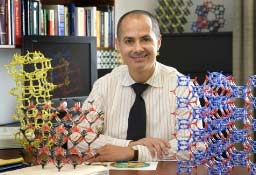UCLA scientists have demonstrated that they can successfully isolate and capture carbon dioxide, which contributes to global warming, rising sea levels and the increased acidity of oceans. Their findings could lead to power plants efficiently capturing carbon dioxide without using toxic materials.
"The technical challenge of selectively removing carbon dioxide has been overcome," said Omar M. Yaghi, UCLA's Christopher S. Foote Professor of Chemistry and co-author of the Science paper. "Now we have structures that can be tailored precisely to capture carbon dioxide and store it like a reservoir, as we have demonstrated. No carbon dioxide escapes. Nothing escapes — unless you want it to do so. We believe this to be a turning point in capturing carbon dioxide before it reaches the atmosphere."
The carbon dioxide is captured using a new class of materials designed by Yaghi and his group called zeolitic imidazolate frameworks, or ZIFs. These are porous and chemically robust structures, with large surface areas, that can be heated to high temperatures without decomposition and boiled in water or organic solvents for a week and still remain stable.
Rahul Banerjee, a UCLA postdoctoral research scholar in chemistry and Anh Phan, a UCLA graduate student in chemistry, both of whom work in Yaghi's laboratory, synthesized 25 ZIF crystal structures and demonstrated that three of them have high selectivity for capturing carbon dioxide (ZIF-68, ZIF-69, ZIF-70). "The selectivity of ZIFs to carbon dioxide is unparalleled by any other material," said Yaghi, who directs of UCLA's Center for Reticular Chemistry and is a member of the California NanoSystems Institute at UCLA. "Rahul and Anh were so successful at making new ZIFs that, for the purposes of reporting the results, I had to ask them to stop."
The inside of a ZIF can store gas molecules. Flaps that behave like the chemical equivalent of a revolving door allow certain molecules — in this case, carbon dioxide — to pass through and enter the reservoir while blocking larger molecules or molecules of different shapes. "We can screen and select the one type of molecule we want to capture," Phan said. "The beauty of the chemistry is that we have the freedom to choose what kind of door we want and to control what goes through the door."
"The capture of carbon dioxide creates cleaner energy," Yaghi said. "ZIFs in a smokestack would trap carbon dioxide in the pores prior to its delivery to its geologic storage space." Currently, the process of capturing carbon dioxide emissions from power plants involves the use of toxic materials and requires 20 to 30 percent of the plant's energy output, Yaghi said. By contrast, ZIFs can pluck carbon dioxide from other gases that are emitted and can store five times more carbon dioxide than the porous carbon materials that represent the current state-of-art. "For each liter of ZIF, you can hold 83 liters of carbon dioxide," Banerjee said.
On a fundamental level, the invention of ZIFs has also addressed two major challenges in zeolite science. Zeolites are stable, porous minerals made of aluminum, silicon and oxygen that are employed in petroleum refining and are used in detergents and other products. Yaghi's group has succeeded in replacing what would have been aluminum or silicon with metal ions like zinc and cobalt, and the bridging oxygen with imidazolate to yield ZIF materials, whose structures can now be designed in functionality and metrics.

